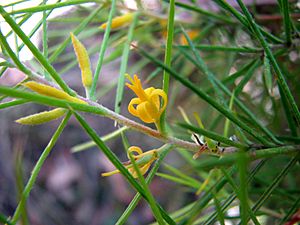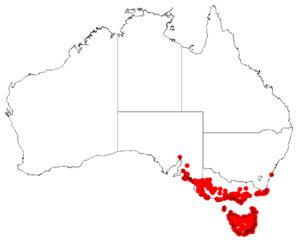Prickly geebung facts for kids
Quick facts for kids Prickly geebung |
|
|---|---|
 |
|
| In Otway Forest Park, Victoria | |
| Scientific classification | |
| Genus: |
Persoonia
|
| Species: |
juniperina
|
 |
|
| Occurrence data from Australasian Virtual Herbarium | |
The Persoonia juniperina, often called the prickly geebung, is a type of flowering plant. It belongs to the Proteaceae family. This plant is special because it only grows in south-eastern Australia. It's a small bush that can stand up tall or spread out low. It has smooth bark and new branches that are a bit hairy. Its leaves are long and thin. The plant grows yellow flowers, either one by one or in groups of up to forty. These flowers appear where the leaves meet the stem. After flowering, it produces yellowish-green to purplish fruit.
Contents
What Does the Prickly Geebung Look Like?
The prickly geebung is a bush that can grow from about 1 foot (0.3 meters) to 6.5 feet (2 meters) tall. It has smooth bark and young branches that are covered in fine hairs. Its leaves are long and narrow, usually 8 to 35 millimeters (about 0.3 to 1.4 inches) long and 0.7 to 1.5 millimeters (about 0.03 to 0.06 inches) wide.
The flowers grow either alone or in groups of up to forty. They appear on a stem called a rachis, which can be up to 150 millimeters (about 6 inches) long. After the flowers bloom, this stem often grows into a leafy shoot. Each flower sits on a short, hairy stalk called a pedicel. The flower parts, called tepals, are yellow and sometimes have hairs on the outside. They are 7 to 11 millimeters (about 0.3 to 0.4 inches) long and have yellow anthers inside. Prickly geebungs usually flower from December to February. Their fruit is an oval-shaped drupe, which is a type of fleshy fruit with a hard pit inside. It's about 10 millimeters (0.4 inches) long and 8 millimeters (0.3 inches) wide, and its color can range from yellowish-green to purplish.
How Scientists Classify the Prickly Geebung
The prickly geebung was first officially described in 1805. A French scientist named Jacques Labillardière wrote about it in his book Novae Hollandiae Plantarum Specimen. He studied plants he found in Tasmania.
Today, scientists recognize four different types, or "varieties," of P. juniperina. These are:
- Persoonia juniperina var. brevifolia
- Persoonia juniperina var. juniperina
- Persoonia juniperina var. mollis
- Persoonia juniperina var. ulicina
The prickly geebung belongs to a larger group of plants called Persoonia. Within this group, P. juniperina is part of the "lanceolata group." This group includes 54 types of Persoonia plants that have similar flowers but very different leaves. When two plants from this group grow near each other, they can sometimes mix and create new kinds of plants.
Where Does the Prickly Geebung Live?
You can find the prickly geebung in many places across south-eastern Australia. It grows all over Tasmania. On the mainland, it's found from a place called Green Cape in southern New South Wales, all the way through Victoria, and into south-eastern South Australia, reaching as far west as Adelaide. This plant prefers to live in sclerophyll forests and heathlands. These are types of bushland where plants have tough, leathery leaves to help them survive dry conditions. It can grow at altitudes up to 700 meters (about 2,300 feet) above sea level.
How Does the Prickly Geebung Reproduce?
Scientists have studied how the prickly geebung makes new plants. They found that it can sometimes pollinate itself, meaning it can use its own pollen to create seeds. However, the plant produces many more fruits and seeds when it is pollinated by pollen from a different prickly geebung plant. This is called cross-pollination.

